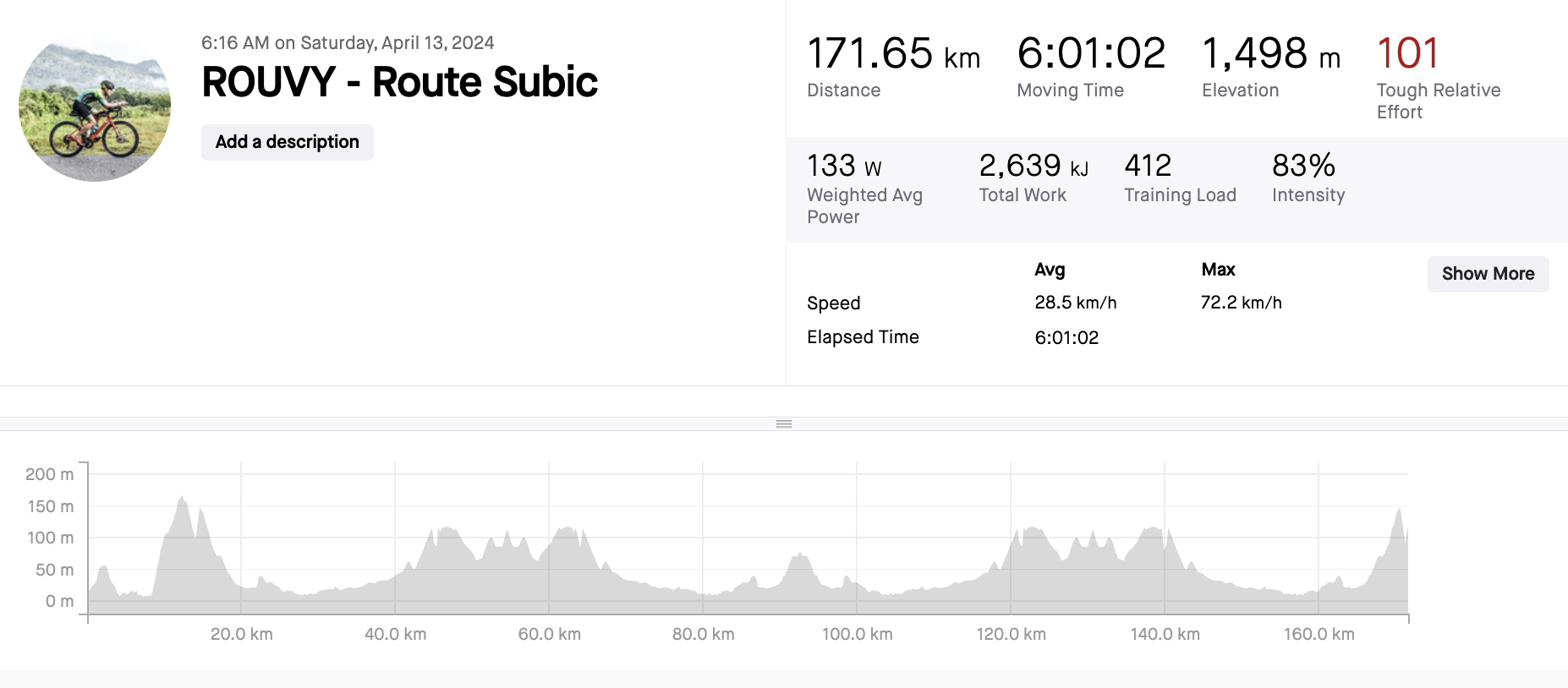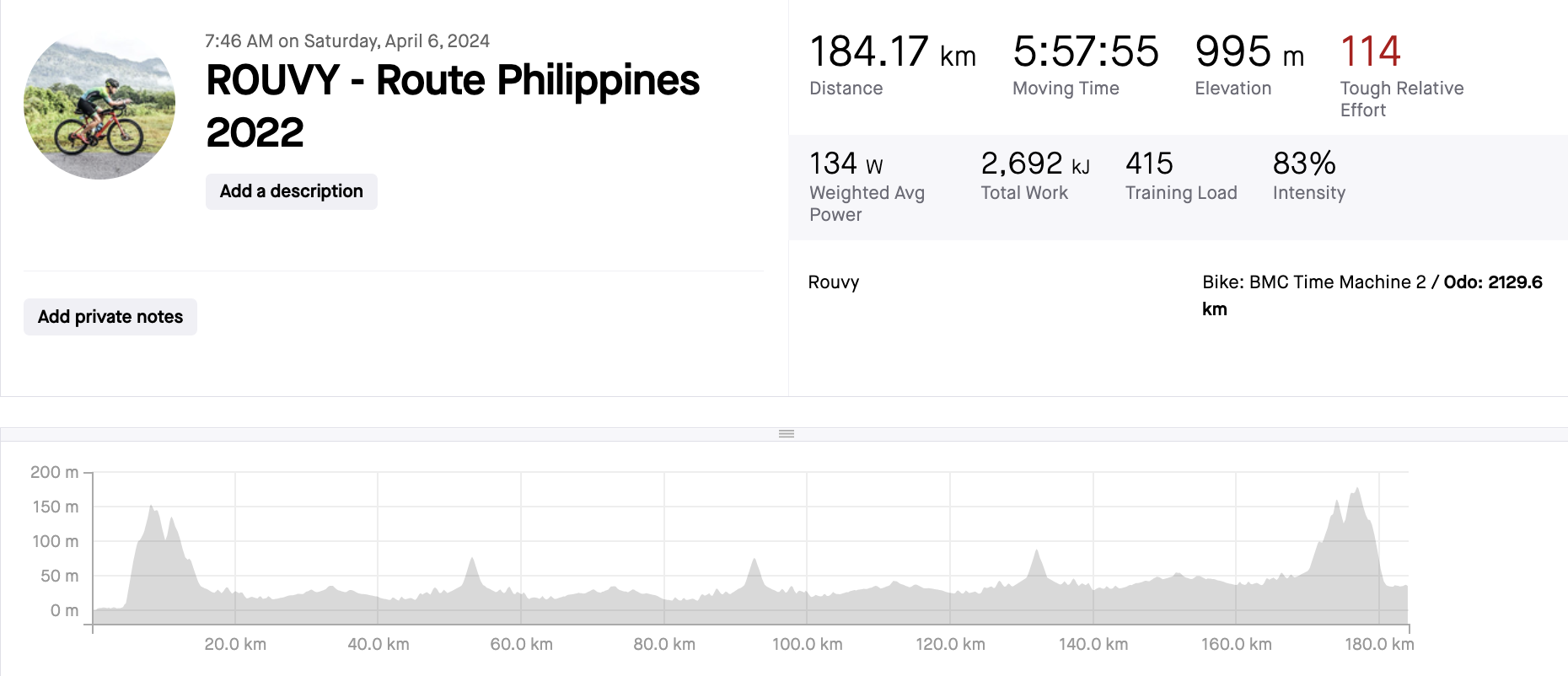In preparing for Ironman Philippines 2024 on June 9, 2024 (8 weeks away), I need to do a few long bike rides. It’s logistically challenging to go out for so many hours, breathing in the polluted city air, and through the hustle and bustle of mixed traffic of motorbikes, cars, and trucks. I should try to do at least one long outdoor ride, but for now, I’m grateful enough that I have managed two long rides indoor.
I did that last Saturday and just did it again today. A 6-hour indoor ride followed by a half-hour run (also known as a brick). On Sunday (tomorrow, same as last week) I would run another ~2-hour slow long run (18-20km) to wrap up the week.
Here’s my bike ride today.

I did another long ride last week. I covered a little more distance last week over the same duration, but the main reason is due to the different bike route profiles uploaded by different users. The elevation gain was lower last week (995m instead of 1500m).

So what’s interesting to write about about? Mentality and nutrition. Today, I’ll focus on nutrition.
But first, I want to acknowledge the mental challenge. Spinning on a bike without a break for 6 hours is no joke. It’s not only physically draining to spin the wheels for that long, but also mentally uncomfortable. I consider myself still weak when it comes to just riding in solitude for that long. I need a distraction. I tend to watch movies during my long rides. For now, podcasts and movies help with the motivation. It gives me something to look forward to before the long workout and something to distract the monkey mind while maintaining the physical forces. This user-loaded route on Rouvy has no video, so I use it mainly as a dashboard to see speed, heart rate, and inclination. Inclined climb is one benefit of indoor rides compared to the flat outdoor roads where I live.
Okay, let’s dive into nutrition. For the first time, I am going to be more attentive to nutrition intake. I did not pay attention to it last week, but I started today. Here’s what I consumed:
- 4 GU energy gels (2 regular, 2 liquid)
- 500ml water mixed with two scoops of Tailwind (in a bottle)
- 750ml iced water (1.5 bottles)
- One ear of steamed corn
Corn was probably not a good idea due to its complex carb structure, but from the 4th hour onwards, my body was sick of sugary stuff. I need to do some research for next time. I did not prepare any salt to use, but I didn’t push too hard and didn’t suffer any cramps. The post-bike run was comfortable enough (with just water).
First, let’s tally up the consumption:
| Product | Quantity | Total Calories | Total Carbohydrates (g) | Total Sodium (mg) |
|---|---|---|---|---|
| GU Energy Gel | 4 gels | 400 | 88 | 500 |
| Tailwind Scoop | 2 scoops | 200 | 50 | 620 |
| 600 | 138 | 1120 |
Now compare with the total calories I burned (reported as 2526 calories via Garmin) and with the suggested liquid intake for continuous activities and sodium for lost sweat.
| Nutrient | Actual Consumption | Required for 6 Hours | Deficit for 6 Hours | Deficit per Hour |
|---|---|---|---|---|
| Calories (kcal) | 600 | 2526 (actual) | 1926 | 321 |
| Carbohydrates (g) | 138 | 180-360g (ideally) | 42-222 g | 7-37 g |
| Fluids (liters) | 1.25 | 3-4.5 (ideally) | 1.75-3.25 liters | 0.29-0.54 liters |
| Sodium (mg) | 1120 | 2300-4600 (ideally) | ~1100-3000 mg | 150-400mg |
Clearly, from this table, my calorie deficit seems high (1926). However, an average person can store 1500-2000 calories worth of glycogen in muscles and liver (depending on carb loading in the meals prior; the body can store about 400-500g of glycogen, each gram releasing about 4 calories). On an hourly basis, glycogen can supply 200+ calories per hour but will decrease over time.
I also noticed a 2kg weight loss after the ride. This was probably mostly a sweat loss, but I wonder if there’s any fat loss involved. I let dehydration happen.
Coming from not knowing much, I simplify my newly gained knowledge of personal data as follows:
- My body burns 400+ cal/bike-hour and 600+ cal/run-hour at moderate intensity
- Energy mix helps with 100-200 calories/hour depending on my intake
- Glycogen can help with 200+ calories/hour, but decreasing over time, and is dependent on my quick-energy intake
- Combat taste fatigue: we prefer sweet stuff in the first few hours but crave salty stuff later. This affects quick-energy and electrolyte choices.
Next: A speed wobble